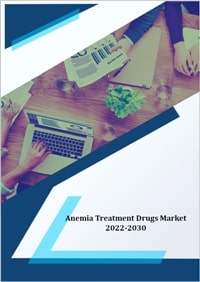
Industry Outlook
Anemia treatment drugs market accounted for a market value of US$ 38,345.2 Mn in 2021 and projected to grow at a CAGR of 16.4% during the forecast period from 2023 to 2030. An abnormal decrease in the level of red blood cells, irregular red blood cell morphology, or inadequate concentration of haemoglobin in the blood results in anemia. Anemia is caused also due to numerous nutritional and non-nutritional factors such as infectious disease including malaria, soil-transmitted- helminthiasis, hookworm, and tuberculosis). The World Health Organization (WHO) estimated that globally anemia prevalence averaged 56%, with geographical variations in Europe & Asia the prevalence is in a range from 35% to 75%.
"Sickle cell anemia market expected to grow at a significant rate in the coming years due to presence more than five molecules in clinical trials phase III owned by large pharmaceutical companies"
During the forecast period from 2023 to 2030, sickle cell anemia will grow at an exponential rate due to rising prevalence & awareness related to sickle cell anemia, and expected market entry of monoclonal antibodies and other biological drugs to treat sickle cell anemia efficiently. According to World Health Organization (WHO), it is estimated that 312,000 children will be born worldwide with sickle cell anemia annually. Globally, the greatest burden exists in Sub-Saharan Africa, where 75% of the world sickle cell disease occurs. However, the three major molecules targeting sickle cell anemia in clinical trial phase III are Rivipansel (Pfizer, Inc.), Voxelotor (Global Blood Therapeutics, Inc.) and GBT440 (Global Blood Therapeutics, Inc.). Thus, market approval of these drugs in the near future will assist the overall growth of sickle cell anemia treatment market.
"Asia Pacific expected to be the fastest growing region in the global anemia treatment drugs market with highest prevalence of anemic population, and increasing awareness related to the diagnosis & treatment of anemia"
During the forecast period from 2023 to 2030, Asia Pacific expected to grow significantly due to rising prevalence & awareness related to anemia, initiation of anemia awareness campaigns by government & non-government organizations, and developing economic & healthcare infrastructure. According to the Sickle Cell Disease Coalition (SCDC), in 2016 India set a world record for screening 7.5 million people for SCD in a single day with help of effective awareness campaigns carried out by both government & non-government organizations. The key development observed in Asia Pacific was associated with the improvement in screening, interventions, skilled healthcare providers, and accessibility for medicines. The strong drug pipeline for anemia treatment also considered as one of the key factors expected to assist the growth of Asia Pacific anemia treatment drugs market in the near future.
This report further describes the major qualitative assessment factors including key market trends, market drivers & restraints, to assist in better understanding of global anemia treatment drugs market. The major players analyzed based on their product offering, market strategies, recent developments, and business strength. The report also provides attractive investment proposition based on the exhaustive geographical research carried out based on PESTEL analysis. Major companies profiled in the report include Pfizer, Inc., Amgen, Inc., Hoffmann-La Roche Ltd., Merck Sharp & Dohme Corp., Novartis AG, Janssen Pharmaceutical, Bayer AG, AMAG Pharmaceuticals, GlaxoSmithKline plc, Akebia Therapeutics, Vifor Pharma Management, Ltd., and FibroGen, Inc. among others.
Historical & Forecast Period
This study report represents analysis of each segment from 2022 to 2032 considering 2023 as the base year. Compounded Annual Growth Rate (CAGR) for each of the respective segments estimated for the forecast period of 2024 to 2032.
The current report comprises of quantitative market estimations for each micro market for every geographical region and qualitative market analysis such as micro and macro environment analysis, market trends, competitive intelligence, segment analysis, porters five force model, top winning strategies, top investment markets, emerging trends and technological analysis, case studies, strategic conclusions and recommendations and other key market insights.
Research Methodology
The complete research study was conducted in three phases, namely: secondary research, primary research, and expert panel review. key data point that enables the estimation of Anemia Treatment Drugs market are as follows:
Market forecast was performed through proprietary software that analyzes various qualitative and quantitative factors. Growth rate and CAGR were estimated through intensive secondary and primary research. Data triangulation across various data points provides accuracy across various analyzed market segments in the report. Application of both top down and bottom-up approach for validation of market estimation assures logical, methodical and mathematical consistency of the quantitative data.
| ATTRIBUTE | DETAILS |
|---|---|
| Research Period | 2022-2032 |
| Base Year | 2023 |
| Forecast Period | 2024-2032 |
| Historical Year | 2022 |
| Unit | USD Million |
| Segmentation | |
Anemia
| |
Drug
| |
|
Region Segment (2022-2032; US$ Million)
|
Key questions answered in this report